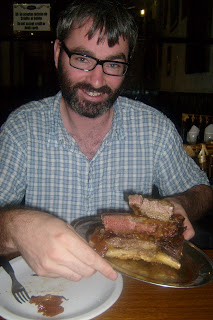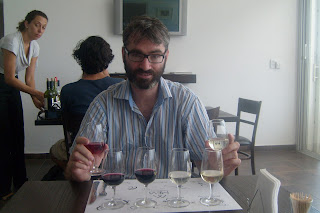Santiago, Chile
==================
The trip from Mendoza, Argentina to Santiago in Chile crossed the Andes. The border crossing was very chaotic, with many people travelling as it was just before the New Year. It took about 3 hours to clear immigration, but the wait was worth it on the ascent down the Andes to Santiago.
New Year's Eve
===================
We were lucky enough to be staying in a 25 storey apartment complex in the centre of town. We were able to get onto the roof of the building for the New Year's Eve fireworks that were taking place about 2 blocks from where we were. They lasted about half an hour or so, and we could see and hear parties continuing in our building throughout the night.
Museum of Memory and Human Rights
============================
The ex-President of Chile, Michelle Bachelet, was one of Augusto Pinochet's many victims. Although she survived his prison camp, many thousands didn't. Just before she left office in 2010, she was the driving force behind a new museum in Santiago - the Museum of Memory Human Rights. This documents the coup against Salvador Allende on September 11th, 1973, the aftermath of the coup, the prison camps, the disappeared, and the search for justice. It's a great memorial to all those who suffered during the dictatorship.
The miners
=======================
Chile is famous for its mines - copper in particular. We spent half a day in a city called Copiapo, near where the Chilean Mining Incident happened in 2010, where 33 miners spent 69 days underground before being rescued. We met a taxi-driver who had worked in that mine before that incident. He told us the work was hard and that he's too old for it now, but that for many people the salaries offered are relatively high by Chilean standards. On the way to the Atacama Desert in the north, where there are lots of mines, we were in buses with lots of miners on their way to work. They got off at various stages of the journey and were picked up in trucks - off to start another stint underground.
The Atacama Desert
===========================
The Atacama Desert is the driest place in the world. We travelled for about 7 hours through the desert and saw nothing but hard sand plains - it was one of the most amazing sights we've ever seen. Desert scenes in films do no justice to the real thing! The reason for our journey through the desert was to get to a place called San Pedro de Atacama which is a small town on the Chilean/Argentinian/ Bolivian border. We wanted to take a stargazing tour with a French Astrologist that is located there. He owns an ELT (extremely large telescope), as he calls it. San Pedro de Atacama gets 360 clear sky nights per year and is one of the best places in the world to see the stars and planets in all of their glory, however, as Murphy’s Law would have it we arrived during a full moon and we brought the clouds with us so the notice on the door spelt it out......All tours cancelled!!!
Geysers
==========
All was not lost when our stargazing tour was cancelled - it gave us the opportunity to take an early morning tour to see the highest geysers in the world at 4,300 metres above sea level. With the landscape having received a battering from the rain the evening before, we set off in a transit van on a fairly hair raising journey to the geyser fields. What a sight to behold at 6.30am - steam gushing high into the sky from bubbling pools of water surrounded by snow covered mountains with wandering llambas spread about the place - and the temperature at minus ten. The power of nature is something else! We both felt a little woozy from the altitude as we ate our geyser cooked boiled eggs and drank our naturally warmed chocolate milk. We finished it all off by taking a dip in the thermal spring - it's a tough life!
Sunday, 8 January 2012
Argentina
The Iguacu Falls
=========================
The Iguacu Falls is on the border with Argentina and Brazil and we spent two days here, one on each side. You get much nearer the water on the Argentinean side, so this was definitely our favourite. There are about 275 falls dropping about 80- metres, with the highlight being a fall called the Devil's Throat - where about 1.8 million litres of water falls every second.
Buenos Aires
========================
We ended up in Buenos Aires for a week in an area called San Telmo, south of the city centre. San Telmo was a great spot - full of colourful little streets, cafes and restaurants. The area is famous for its Sunday market - although this fell on Christmas Day the market was still in full swing. The area had a real bohemian feel to it and even though we had a wander around Recoleta and Palermo we always ended up coming back to the old reliable San Telmo.
Steak for Christmas Dinner
===========================
There was very little build up to Christmas in Argentina. At midnight, however, the fireworks started. Even the police across from our hostel got in on the act - letting their sirens go on for about 20 minutes and ignoring all the illegal fireworks exploding all around them. The Chinese shopkeeper below us forgot that there was a second level to the building when he started letting of his fireworks - we were lucky to come out of it safely as we watched from above.....On Christmas Day, we had planned a Tango Show followed by a Christmas Dinner of steak. Although we never got to a show, the Christmas Dinner more than made up for it.
Boca Juniors
======================
San Telmo borders an area called La Boca, which was the first port of call for many European immigrants in the last century. La Boca is now most famous for its football team - Boca Juniors. Boca is the team of most of Buenos Aires now, with plenty of the restaurants and bars having Boca memorabilia on the walls. Diego Maradona played for Boca at the beginning and the end of his career, and there are still many murals of him around the stadium where Boca plays.
Cycling in the wineries
===========================
After Buenos Aires, we took a 15 hour journey to Mendoza, in the West of Argentina. Mendoza is the wine capital of Argentina, and is one of the nine Global Network great wine capitals of the world. Nearly all of Argentina's wine is produced here. We rented out the bikes, got a map and cycled around to different wineries where we were given tours and tasting sessions - One of our more enjoyable days so far.
Transport in Argentina
============================
The buses in Brazil and Argentina are great. There are three general levels of long distance bus - the semi-cama (or half-bed), the cama (bed) and the premium cama. There are only three seats per row in the cama and premium cama giving very wide seats and lots of leg room. You can also recline the seat half way back (cama) or fully back (premium cama) without disturbing the person next to you. Food and blankets are provided, and there is also a coffee machine on board as well.
=========================
The Iguacu Falls is on the border with Argentina and Brazil and we spent two days here, one on each side. You get much nearer the water on the Argentinean side, so this was definitely our favourite. There are about 275 falls dropping about 80- metres, with the highlight being a fall called the Devil's Throat - where about 1.8 million litres of water falls every second.
Buenos Aires
========================
We ended up in Buenos Aires for a week in an area called San Telmo, south of the city centre. San Telmo was a great spot - full of colourful little streets, cafes and restaurants. The area is famous for its Sunday market - although this fell on Christmas Day the market was still in full swing. The area had a real bohemian feel to it and even though we had a wander around Recoleta and Palermo we always ended up coming back to the old reliable San Telmo.
Steak for Christmas Dinner
===========================
There was very little build up to Christmas in Argentina. At midnight, however, the fireworks started. Even the police across from our hostel got in on the act - letting their sirens go on for about 20 minutes and ignoring all the illegal fireworks exploding all around them. The Chinese shopkeeper below us forgot that there was a second level to the building when he started letting of his fireworks - we were lucky to come out of it safely as we watched from above.....On Christmas Day, we had planned a Tango Show followed by a Christmas Dinner of steak. Although we never got to a show, the Christmas Dinner more than made up for it.
Boca Juniors
======================
San Telmo borders an area called La Boca, which was the first port of call for many European immigrants in the last century. La Boca is now most famous for its football team - Boca Juniors. Boca is the team of most of Buenos Aires now, with plenty of the restaurants and bars having Boca memorabilia on the walls. Diego Maradona played for Boca at the beginning and the end of his career, and there are still many murals of him around the stadium where Boca plays.
Cycling in the wineries
===========================
After Buenos Aires, we took a 15 hour journey to Mendoza, in the West of Argentina. Mendoza is the wine capital of Argentina, and is one of the nine Global Network great wine capitals of the world. Nearly all of Argentina's wine is produced here. We rented out the bikes, got a map and cycled around to different wineries where we were given tours and tasting sessions - One of our more enjoyable days so far.
Transport in Argentina
============================
The buses in Brazil and Argentina are great. There are three general levels of long distance bus - the semi-cama (or half-bed), the cama (bed) and the premium cama. There are only three seats per row in the cama and premium cama giving very wide seats and lots of leg room. You can also recline the seat half way back (cama) or fully back (premium cama) without disturbing the person next to you. Food and blankets are provided, and there is also a coffee machine on board as well.
Subscribe to:
Posts (Atom)











